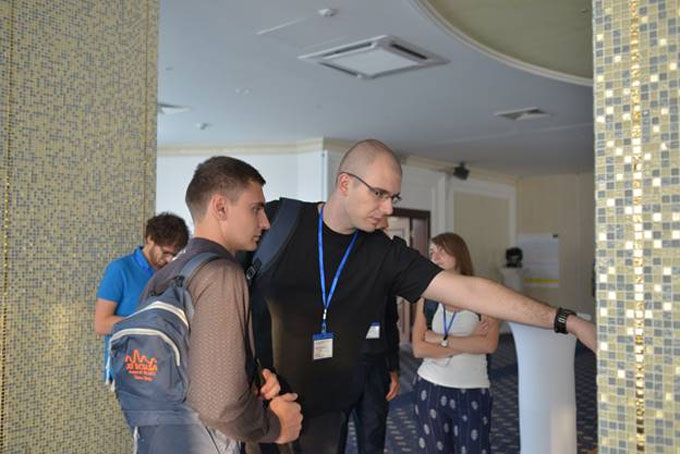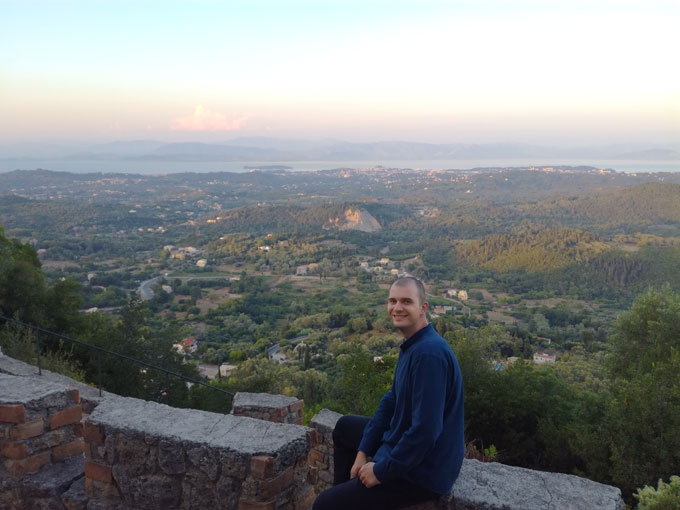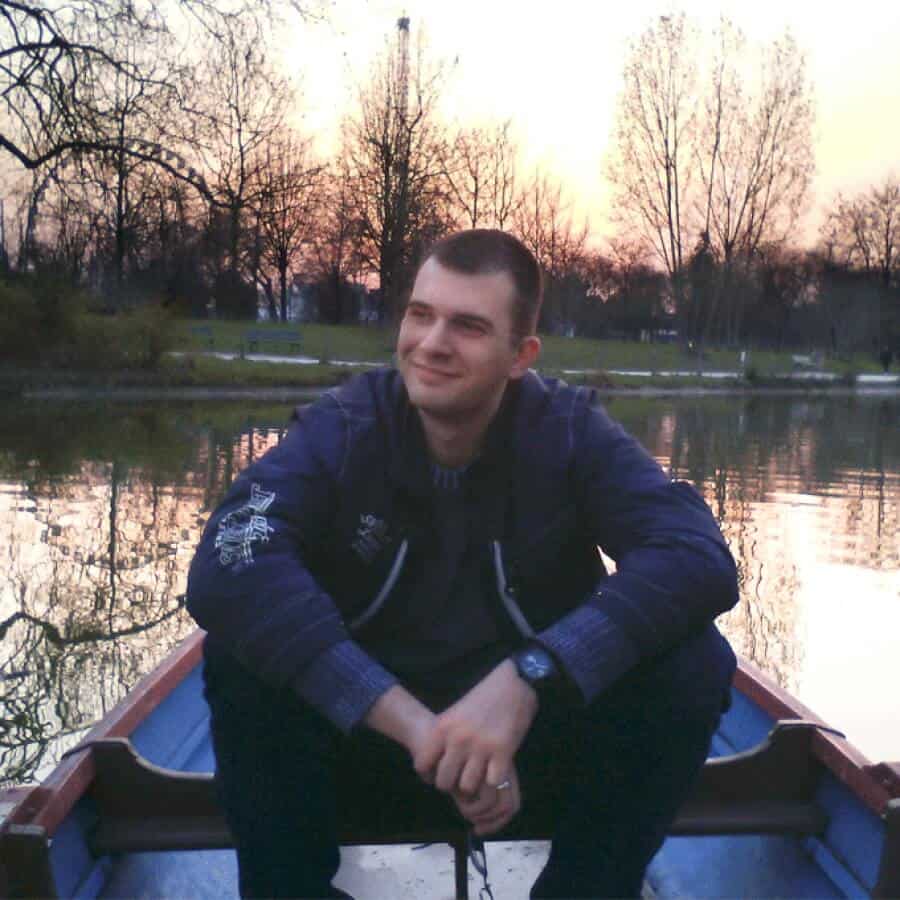Mihailo Martinovic (30), from Serbia, always wanted to be a Physics teacher in high school. However, life had different plans for him and instead, with a little bit of help from his Professors and thanks to his hard work through the years, he became a talented scientist with worldwide connections. He won the Youth Hero 2017 award for achievements in education and science at the age of 29 and was the youngest Doctor of Astronomy in Serbia at the time. Today, Mihailo enjoys his job working on a Solar Orbiter project as a part of an international team of scientists at the European Space Agency, exploring something called solar wind plasma!
Mihailo, tell us when was the first time you took an interest in physics and astronomy, and who were the people who encouraged you the most in pursuing your dream of becoming a scientist?
I competed on the regional level in Mathematics and Physics during elementary and high school, and also was pretty sure that I would study Physics, but in order to become a high school teacher, not a scientist. I didn’t choose the teaching curriculum (General Physics), but rather Applied Physics and Informatics, as I wanted a bit of an “insurance policy“ if I changed my mind during my studies.
This is exactly what happened after three (out of a total of four) years. It was during the course Optical Spectroscopy, given by Prof Ivan Dojcinović, when I thought Hey, I might like to do this for a longer period of time, for the first time.
I worked with him and Professor Jagos Purić for two years did a master’s thesis and had a great opportunity to do a PhD in Nagoya, Japan. Unfortunately, I had to refuse it as I wanted to stay near my father, who had some serious health issues at the time. Anyway, by that point, I was aware that I was too much into science to quit.
As for astrophysics, I got interested in it by simply talking to colleagues from the Astronomy Department, as we shared some courses and hung out a bit outside of lectures. It was not my first choice for future scientific work, at least not until Professor Stevo Šegan proposed that I do a Serbian-French co-mentored PhD.
This program was way more suitable for me, as it enabled me to have all the benefits of studying abroad without losing my connection to the people who mean the most to me in my home country.
Were there any teachers or professors whom you admired the most, and is there any inspiring professional advice you got from some of them that you would like to share with us?
As my PhD was set up, I started working with Professor Milorad Kuraica and Bratislav Obradović at the Laboratory of Physics and Technology of Plasmas. These people have educated scientists who have achieved worldwide recognition, after starting the laboratory from scratch. The six months I spent with them was the time when I actually understood what it means to be an academically strong, independent scientist, and how much I needed to learn in order to achieve at that level.
During that time, I got a lot of useful advice, as well as multiple catchy but deep proverbs – Science is a craft, especially during experiments, so you need to spend time living with it in order to learn. Also – When you get out of the lab and work somewhere else in the world, the only thing you must do is make an impression that will open doors for the ones who come after you, not close doors in their faces.
The other part of my development was greatly empowered by Arnaud Zaslavsky and Milan Maksimović, my PhD advisors at the Paris Observatory. Zaslavsky made me understand why it is essential not to skip steps in my development and that being reliable is much better that being super-effective. One of the key thoughts that has meant a lot to me was – What you write and publish stays as your memo forever, no matter if you did it in one or in five months. Science is not a sport where speed is paramount.
All of this (and so much more, I could actually continue these quotes for five pages) has been priceless for me in both science and life, in general.

Mihailo Martinovic
You mentioned once the two professors who showed you how it looks when a student becomes a scientist. So tell us, what does this transition look like, and when did you feel that you were not just a student anymore and that you were becoming a scientific professional who could impact the world of astrophysics with your work?
The difference can be summed up in one sentence – a student learns, a scientist explores. In more detail, a student learns material that is already well established and put into textbooks. And when you spend five years passing dozens of exams, you become very good at it.
Afterwards, you naturally tend to transpose the same approach to scientific problems. However, what worked well when you worked with well-known subjects is not a good way to do things when you face a problem that has never been dealt with before. In science, instead of memorizing what is written and putting good trust in it, you should constantly reevaluate your conclusions and results, as well as (with all due respect to colleagues) results from other authors, double-check and quadruple-check them until you are sure that you have a good result. By ”good result“ I mean a result that is correct, meaningful, significant, reproducible and clearly presented to readers who are familiar with the scope of your area.
How would you describe the current state in Serbia regarding research possibilities in the fields of astronomy and astrophysics, having in mind most of your colleagues choose to work abroad?
Wow, this is a question that a lot of people way smarter than myself haven’t managed to give a correct answer to. You should probably ask some of the older Professors, who have a better view of the big picture of Serbian science. However, I can give it a try from my reference point.
Namely, I have spoken to people who have left the country (with quite a lot of them) and listened to their reasons for doing so. Surprisingly, the main reason was almost never the salary. Simply, if your ambition is for your salary to be five times the national average then you shouldn’t be in science in the first place.
However, accessibility to other important tools needed for quality work does come up: equipment, supporting manpower (engineers, administrative staff), traveling, participation in international projects and organizations, PhD student funds (especially in experimental fields), publication fees support, etc. is what is lacking. All of these are the assets needed to do astrophysics (as well as science in general) at the top level.
So, even if your salary is decent, if you don’t have additional support for the points given above, you will not be able to get the best out of yourself and, naturally, you will become dissatisfied and look for a better option somewhere else. From here, my suggestion to people in charge is: if you are ever able to invest more in science, don’t just increase salaries across the board. Rather give the scientists more tools to work with.
You have been awarded numerous scholarships so far. Tell us which one was especially significant for you and a bit more about the experience.
I would give the most attention to the NIS and Exit Foundation’s Youth Heroes Award, which I won in 2017. I think it is a very good and “healthy” competition because the jury evaluates multiple aspects of the candidate’s profile, including hobbies, future plans, and relationships with the people around him/her.
This was why I felt very happy to win the competition since I felt that I had been observed as a full personality, not just a CV on paper. That particular feeling was fully confirmed when I met some of the jury members afterwards (will not give names here since there is a high probability the same people will be on the jury this year as well).
They were truly honored to read the resumes of the participants, memorized a lot of details about everybody, wanted to meet the candidates in person, and when we discussed matters, they honestly wanted to hear what younger people had to say. It is easy to compare this with the classic situation in which you receive an envelope by post, informing you that you have (or have not) obtained a scholarship.
Having in mind you have experienced co-mentorship studies at the University of Belgrade and at the Paris Observatory, can you compare these two approaches to mentoring? What did you like the most in France and about the way they teach young experts?
It is well-known that there are two basic models of education: American and Soviet. The first one puts you into practical work from day one, prioritizing learning through work, while the other one gives a better theoretical background, but less practice, at least in the first couple of years. Both systems have produced numerous world-class experts, and neither of them is, in my opinion, better than the other one.
The Serbian and French approaches are somewhere in between these two although, as might be expected, the French system is a bit more “western” as can be seen through the requirements, the number and scope of exams, and many other aspects of the work.
On the other hand, there is a notable difference in relations between advisors and PhD students in the two countries. For example, in France it is perfectly normal for students and advisors to have a couple of drinks or an informal dinner after work or to visit each other in their homes with families.
These close relations also exist in Serbia (I have experienced them personally) but are indeed very rare. Again, even though I prefer the French approach, I don’t claim that one way of doing things has advantages over the other one, as in the end, it comes down to a particular situation.
You are part of a prestigious international team of scientists at the European Space Agency in the Solar Orbiter mission, and you research something called solar wind plasma. Can you tell us more about this phenomenon and what will be the first research initiatives once the project starts?
The Sun emits energy in two ways – by radiation and by particles. The first one is known as solar light and the other as solar wind. The temperatures (by temperature we don’t presume the traditional understanding of heat, but rather average kinetic energy per particle) are a lot higher in the solar wind then on the Solar surface, and this is why the particles are not creating neutral but ionized gas, which is the definition of plasma.
The physical mechanisms that heat and accelerate the solar wind are not yet understood, and the main task of future missions will be to reveal and describe them.
On the way to the final answer, the first step (after launch) is to collect and process the large body of measurements that will be needed to verify numerous theoretical models. This will be, at least for the scientists, the most interesting period, because the first view of the data always reveals something important, confirming (or denying) existing theories.
However, it is important to note that the project actually started 10 years ago and that hundreds of people, mostly engineers, are doing very hard work before launch, led by their respective principal investigators and project managers. Their doing a good job now is what enables us to make good science later.

Mihailo Martinovic
What does your work day look like today?
In my daily routine, I tend to stick to a balanced life concept as much as possible. This means that a person should organize him/herself in a way to have five aspects of living fully covered: job/career, physical activity, spiritual life if you are religious or philosophy/ethics concept if you are not, social life and, last but not least, a hobby.
Of course, there is no time in a single day to cover all of these areas, but inside one week there should be enough time for everything.
And why is this important for work? Simply because, in order to accomplish better results, you need to work hard for longer periods of time and find a way to keep yourself effective and motivated throughout these intervals.
Plus, of course, there is the issue of the general quality of life that nobody can neglect. This is why I don’t tend to attempt more than 8-9 hours of effective work per day, except in special circumstances.
It is important to note that the workday of a scientist begins before coming to work. This is because the job is made up of resolving problems and therefore requires full concentration, so you need to prepare yourself by means of being rested, focused, and motivated. During a classic work day, I tend to do administrative tasks in between scientific ones. This way I give myself a bit of “rest” by doing some straightforward parts of the job.
How would you like to be known and mentioned in the media in 20 years’ time?
In 20 years’ time, I want to be as pretty as I am now! Just kidding…
On a more serious note, the greatest satisfaction for me would be to contribute to Serbian science by expanding its scope in this field. A solar wind plasma school doesn’t exist in Serbia at the moment, so we need to educate PhD students fundamentally by relying on great people from the Paris Observatory.
I hope that in 5-10 years’ time we will be able to establish independent doctorates in Serbia, therefore enabling our students an option that hasn’t exist before. Another thing, very important in my home country, is that this way we can provide jobs for young people, but not only jobs financed by the state, but also (and in the majority of all cases) the ones financed from abroad.
I would be honored to become a man who brought new jobs to Serbia, giving some bright young people a chance to make a living out of their own honest work.
Read more about the best scientist in the world from Serbia here.
Photo credits: Edi Bon/private archive
Support us!
All your donations will be used to pay the magazine’s journalists and to support the ongoing costs of maintaining the site.
Share this post
Interested in co-operating with us?
We are open to co-operation from writers and businesses alike. You can reach us on our email at [email protected]/[email protected] and we will get back to you as quick as we can.










